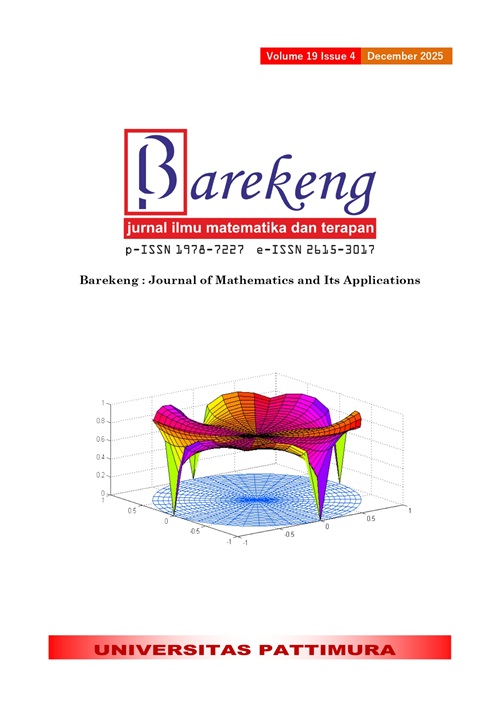AN EXAMINATION OF THE GREEN STOCK PORTFOLIO IN CONNECTION WITH THE 2024 INDONESIAN REPUBLIC PRESIDENTIAL GENERAL ELECTION
Abstract
The presidential election of the Republic of Indonesia occurs on a frequency of once every five years. The present work investigated the impact of the 2024 Presidential Election on the performance of the optimal stock portfolio constructed by K-Means Clustering during the first phase of stock selection. Subsequently, the portfolio will be evaluated using two distinct approaches, namely Mean Absolute Deviation (MAD) and Mean-Variance Efficient Portfolio (MVEP). Both techniques were employed to construct several portfolios throughout three time periods: before the Presidential Election (13 August 2023 to 13 February 2024) and after the Presidential Election (15 February to 15 April 2024 and 20 April 2024 to 20 May 2024). This was done by implementing a mechanism to manage the allocation of shares in order to optimize the portfolio. The analyzed data is historical data on daily green stock closing prices indexed on the SRI-KEHATI index. A portfolio was constructed and subsequently evaluated for its performance using the Sharpe Index. The findings of this study suggest that the upcoming 2024 general election for the presidency of the Republic of Indonesia had a favorable impact on the Indonesian capital market, particularly for stocks that are indexed by SRI-KEHATI. This criterion was proposed based on the observation that the average Sharpe ratio index for Period II and Period III exceeds the average Sharpe ratio index for Period I (prior to the election day). The most optimal portfolio examined in this study was the MVEP portfolio, mostly composed of assets in the primary consumer products industry, with a Sharpe ratio of 0.53586. Furthermore, the performance of portfolios in period III (after the election result release) was far superior to that of other portfolios examined in previous periods.
Downloads
References
K. Upadhyaya, R. Nag, and D. Ejara, “THE 2016 US PRESIDENTIAL ELECTION, OPINION POLLS AND THE STOCK MARKET,” Journal of Financial Economic Policy, vol. 16, no. 2, pp. 194–204, 2024.doi: https://doi.org/10.1108/JFEP-10-2023-0310
T. Nadeak, I. Waspada, and M. Sari, “ANALYSIS OF FACTORS AFFECTING THE PERFORMANCE OF STOCK INVESTMENT PORTFOLIOS IN INDONESIA ARTICLE INFO ABSTRACT,” 2024.doi: https://doi.org/10.58812/wsbm.v2i02.969
H. Hamdani, K. L. Elvaretta, M. A. K. Wardani, and F. Kartiasih, “THE IMPACT OF GENERAL ELECTIONS ON STOCK MARKET VOLATILITY IN INDONESIA (2004–2023),” JPPUMA: Jurnal Ilmu Pemerintahan dan Sosial Politik UMA (Journal of Governance and Political UMA), vol. 12, no. 1, pp. 75–96, 2024.doi: https://doi.org/10.31289/jppuma.v12i1.11126
I. P. A. Argantha and I. Sudirman, “STOCK MARKET REACTION TO THE EVENT OF INDONESIA’S GENERAL ELECTION EVENTS IN 2019,” Amer. J. Hum. Social Sci. Res., vol. 4, no. 1, pp. 202–208, 2019.
L. Castaño, J. E. Farinós, and A. M. Ibáñez, “THE STOCK MARKET REACTION TO POLITICAL AND ECONOMIC CHANGES: THE SPANISH CASE,” Review of Economic Design, pp. 1–38, 2024.doi: https://doi.org/10.2139/ssrn.4607913
A. N. Pratama, N. Satyahadewi, and E. Sulistianingsih, “ANALYSIS OF OPTIMAL PORTFOLIO FORMATION ON IDX30 INDEXED STOCK WITH THE MEAN ABSOLUTE DEVIATION METHOD,” BAREKENG: Jurnal Ilmu Matematika dan Terapan, vol. 18, no. 3, pp. 1753–1764, 2024.doi: https://doi.org/10.30598/barekengvol18iss3pp1753-1764
L. Gubu and D. Rosadi, “ROBUST MEAN–VARIANCE PORTFOLIO SELECTION USING CLUSTER ANALYSIS: A COMPARISON BETWEEN KAMILA AND WEIGHTED K-MEAN CLUSTERING,” Asian Economic and Financial Review, vol. 10, no. 10, p. 1169, 2020.doi: https://doi.org/10.18488/journal.aefr.2020.1010.1169.1186
S. Kalfin and E. Carnia, “PORTFOLIO OPTIMIZATION OF THE MEAN-ABSOLUTE DEVIATION MODEL OF SOME STOCKS USING THE SINGULAR COVARIANCE MATRIX,” International Journal of Recent Technology and Engineering (IJRTE), vol. 8, no. 3, pp. 7820–7828, 2019.doi: https://doi.org/10.35940/ijrte.C6363.098319
A. L. M. Sallan and E. Gemida, “PERFORMANCE ANALYSIS OF A PHILIPPINE REIT AND ITS OPTIMAL ALLOCATION IN A MIXED-ASSET PORTFOLIO,” Philipp J Sci, vol. 151, no. 3, pp. 1229–1240, 2022.doi: https://doi.org/10.56899/151.03.35
D. Saepudin and D. R. Guintana, “STOCK PORTFOLIO OPTIMIZATION ON JII INDEX USING MULTI-OBJECTIVE MEAN-ABSOLUTE DEVIATION-ENTROPY,” International Journal on Information and Communication Technology (IJoICT), vol. 8, no. 1, pp. 30–40, 2022.doi: https://doi.org/10.21108/ijoict.v8i1.623
Y. Pratama, E. Sulistianingsih, N. N. Debataraja, and N. Imro’ah, “K-MEANS CLUSTERING DAN MEAN VARIANCE EFFICIENT PORTFOLIO DALAM PORTOFOLIO SAHAM,” Jambura Journal of Probability and Statistics, vol. 5, no. 1, pp. 24–30, 2024.doi: https://doi.org/10.37905/jjps.v5i1.20298
A. F. Ridwan, S. Subiyanto, and S. Supian, “IDX30 STOCKS CLUSTERING WITH K-MEANS ALGORITHM BASED ON EXPECTED RETURN AND VALUE AT RISK,” International Journal of Quantitative Research and Modeling, vol. 2, no. 4, pp. 201–208, 2021.
S. Roy and R. Bhattacharya, “CLUSTERING MID-CAP STOCKS IN INDIAN MARKET USING MULTI-VARIATE DATA ANALYSIS TECHNIQUE,” Indian J Econ Dev, vol. 7, no. 6, 2019.
I. M. Di Asih, VALUE AT RISK UNTUK PENGUKURAN RISIKO INVESTASI SAHAM: APLIKASI DENGAN PROGRAM R. BuatBuku. com, 2021.
D. Wulandari, D. Ispriyanti, and A. Hoyyi, “OPTIMALISASI PORTOFOLIO SAHAM MENGGUNAKAN METODE MEAN ABSOLUTE DEVIATION DAN SINGLE INDEX MODEL PADA SAHAM INDEKS LQ-45,” Jurnal Gaussian, vol. 7, no. 2, pp. 119–131, 2018.doi: https://doi.org/10.14710/j.gauss.v7i2.26643
Copyright (c) 2025 Evy Sulistianingsih, Shantika Martha, Wirda Andani, Hendri Agustono, Rifki Pebriyandi, Risky Gunawan, Cinta Pricillia Maharani

This work is licensed under a Creative Commons Attribution-ShareAlike 4.0 International License.
Authors who publish with this Journal agree to the following terms:
- Author retain copyright and grant the journal right of first publication with the work simultaneously licensed under a creative commons attribution license that allow others to share the work within an acknowledgement of the work’s authorship and initial publication of this journal.
- Authors are able to enter into separate, additional contractual arrangement for the non-exclusive distribution of the journal’s published version of the work (e.g. acknowledgement of its initial publication in this journal).
- Authors are permitted and encouraged to post their work online (e.g. in institutional repositories or on their websites) prior to and during the submission process, as it can lead to productive exchanges, as well as earlier and greater citation of published works.






1.gif)



